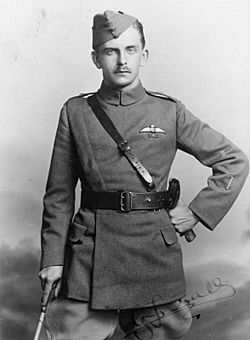Gilbert Insall facts for kids
Quick facts for kids
Gilbert Stuart Martin Insall
|
|
|---|---|

Lieutenant Gilbert Insall c. 1916–17
|
|
| Born | 14 May 1894 Paris, France |
| Died | 17 February 1972 (aged 77) Scrooby, Nottinghamshire, England |
| Buried |
Cremated, Headstone at Rose Hill Crematorium, Doncaster
Headstone at Nocton Churchyard, Lincolnshire |
| Allegiance | United Kingdom |
| Service/ |
British Army (1915–18) Royal Air Force (1918–45) |
| Years of service | 1915–1945 |
| Rank | Group captain |
| Unit | No. 11 Squadron RFC |
| Battles/wars | World War I Iraqi revolt against the British World War II |
| Awards | Victoria Cross Military Cross Mentioned in dispatches |
Gilbert Stuart Martin Insall (born May 14, 1894 – died February 17, 1972) was a very brave British pilot. He earned the Victoria Cross (VC) and the Military Cross (MC). The Victoria Cross is the highest award for bravery given to people in the British and Commonwealth countries. It is given for amazing courage when facing an enemy.
Contents
Gilbert Insall's Bravery in World War I
Gilbert Insall joined the Royal Flying Corps in 1915. This was during the First World War. He became a young officer, called a second lieutenant. He was part of the 11 Squadron.
An Amazing Air Battle
On November 7, 1915, when Insall was 21, he was on patrol over France. He was flying a Vickers F.B.5 Gunbus plane, number 5074. His gunner was a skilled mechanic named T. H. Donald. They spotted a German plane, an Aviatik, with two people inside.
Insall and Donald chased the German plane. They attacked it and forced the German pilot to land roughly in a field. When they saw the German crew trying to get out and prepare to fire, Insall quickly dived his plane very low. His gunner, Donald, opened fire on them. The Germans then ran away.
Escape and Repair Under Fire
After chasing off the Germans, Insall dropped a special bomb on the downed German plane. This bomb set the plane on fire. Insall then flew his plane through heavy enemy gunfire. His plane's fuel tank was hit!
Even with a damaged plane, Insall showed great skill. He managed to fly his plane about 500 yards (about 450 meters) back into friendly territory. He made an emergency landing near a wood.
Insall and Donald stayed with their damaged plane. The Germans fired about 150 shells at them, but the plane was not badly damaged by the shells. However, rifle fire had caused a lot of damage. They waited until nightfall. Then, using flashlights, they worked all night to fix their plane. At dawn, Insall flew them both safely back to their base.
Receiving the Victoria Cross
This incredible act of bravery earned Gilbert Insall the Victoria Cross. The award was announced in a special newspaper publication on December 23, 1915.
However, Insall could not receive his award right away. On December 14, 1915, he and Donald were wounded and captured by the Germans. This happened after another air battle. While he was a prisoner, Insall was promoted to lieutenant.
Insall tried to escape three times. On his third try, on August 28, 1917, he finally succeeded! He crossed the Dutch border and made it home on September 6. King George V personally presented him with his Victoria Cross on September 27, 1917. After returning, he went back to flying.
Life in the Royal Air Force
After World War I ended, Gilbert Insall stayed in the military. He joined the new Royal Air Force (RAF) in 1919. He was promoted several times, becoming a flight lieutenant and then a squadron leader. In 1919, he also received the Military Cross. This award was for his bravery in escaping from being a prisoner of war.
Discovering Ancient Sites
Gilbert Insall was not just a brave pilot; he was also very observant! In 1925, while flying on a clear day, he noticed strange patterns on the ground. These patterns looked like pits. He took a photograph of them. This photo led to the amazing discovery of Woodhenge. This ancient site, from the Bronze Age, is just two miles from Stonehenge.
A few years later, in 1929, he made another similar discovery. He found Arminghall Henge from the air. His aerial photographs helped archaeologists find these important historical places.
Later Career and Retirement
Insall continued his service in the RAF. He served in Iraq in 1927–1928. For his service there, he was mentioned in official reports and received a medal. He was promoted to wing commander in 1929 and then to group captain in 1935. He continued to serve during the Second World War. Gilbert Insall retired from the RAF on July 30, 1945.
He is buried in Nocton Churchyard in Lincolnshire. His Victoria Cross medal is on display at the Royal Air Force Museum in Hendon.

